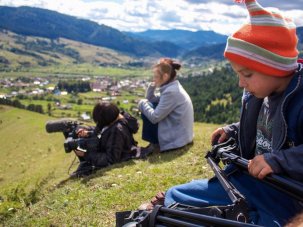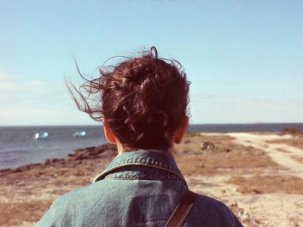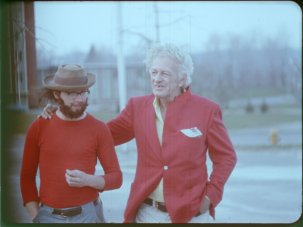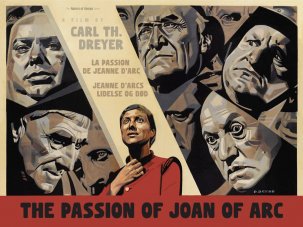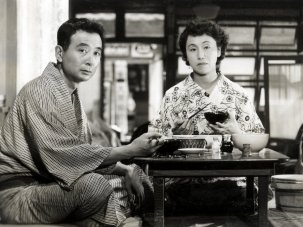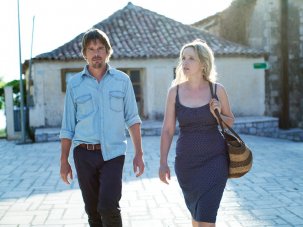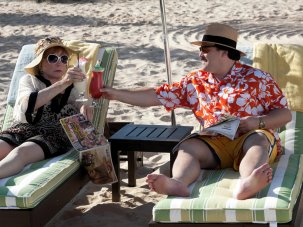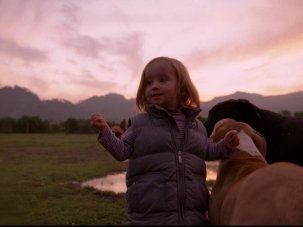Web exclusive
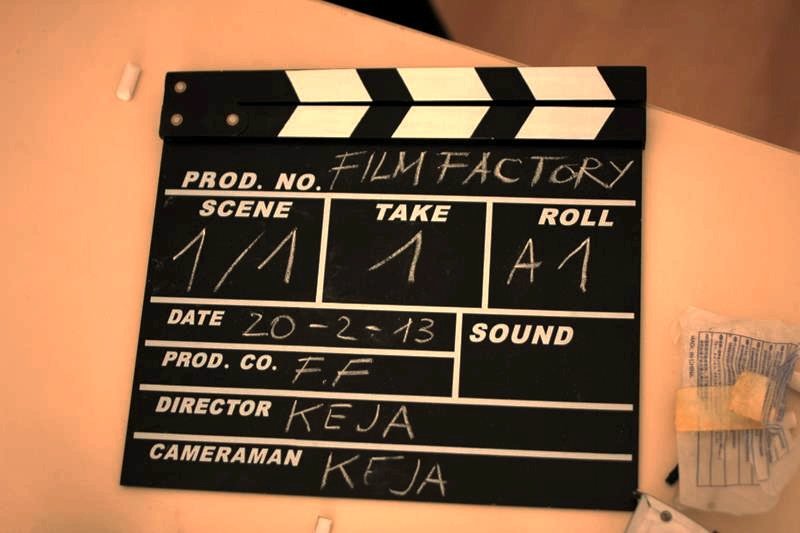
First of all, what is film.factory?
It’s usually thought of and referred to as a film school that’s been recently set up in Sarajevo, housed at the Sarajevo Film Academy. But Béla Tarr, who created it, isn’t happy with this classification. He’d rather call it a workshop or, as its name suggests, a factory that produces films in which he serves as a producer. And he’d rather speak of the 16 filmmakers he selected late last year from 14 countries (Austria, the Czech Republic, France, the Faro Islands, Iceland, Iran, Japan, Mexico, Poland, Portugal, Serbia, Spain, the UK and the US) for his three-year programme – all between the ages of 22 and 38 – as ‘colleagues’ rather than as students. If he’s right, he’s chosen his colleagues well.
But this isn’t to say that his aspirations are entirely free of pedagogical designs. When he first spoke to me about the germ of his overall concept a couple of years ago – at the Era New Horizons Film Festival in Wrocław, Poland, where he was presenting The Turin Horse, already announced as his last film – he said that part of what he had in mind for what he was then calling his “school project” was to explain how everything his students had already been told about filmmaking was a lie.
And then he later asked me to participate by showing and speaking about American independent films, leaving it entirely up to me how I would define that category and clarifying that this would be an elective ‘course’ or activity, not a requirement. Early on, I decided to concentrate on an existential, eclectic and highly personal definition of ‘independent’ that encompassed Stroheim’s Foolish Wives and Greed (the latter had just become commercially available on a Spanish DVD) and Paul Fejos’ Lonesome as well as Thom Andersen, Charles Burnett, Sara Driver, James Benning, Hollis Frampton, Todd Haynes, Val Lewton, Richard Linklater, Elaine May, Mark Rappaport, Nicholas Ray and Leslie Thornton, but only The Struggle when it came to Griffith (although I also included a radio broadcast by Stroheim speaking about Griffith when he died).
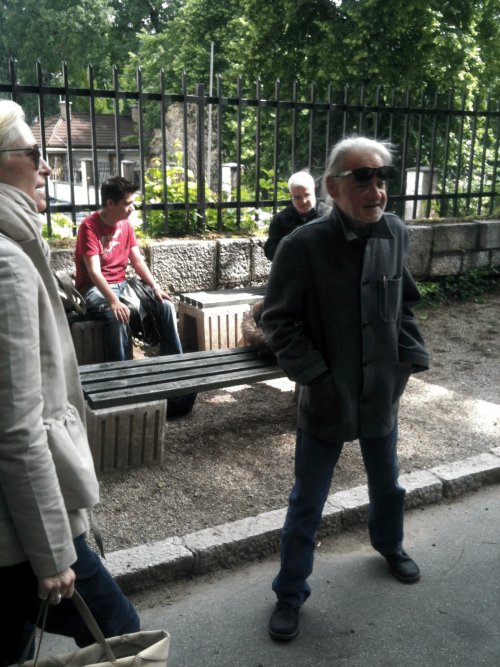
Tilda Swinton and Béla Tarr
Even though I brought along some titles by Welles and Jarmusch, I ultimately opted in most cases for films that hadn’t already been seen or even heard about. And after a screening of Josef von Sternberg’s The Saga of Anatahan with French subtitles that was met mainly with incomprehension, I opted whenever possible for films with English subtitles. (Among the 16, only the oldest and youngest of the members had grown up with English as a first language.) One morning, when I was faced with the prospect of showing Ford’s The Long Voyage Home with Spanish subtitles, one of the two Serbs offered and then managed to find and synchronise English subtitles in time for a screening after our lunch break.
Regarding the programme as a whole, there are no papers or tests or roll-calling – just an expectation that two short films be made by each participant the first year, two more the second year, and hopefully a feature the third. As recently as a year ago, Béla still thought it would be in Split, Croatia, but late last July he sent out a letter explaining that getting accreditation there to hand out PhDs was proving impossible, so another location would have to be found; and less than two months later came his email update, with the news that the Sarajevo Film Academy at the local School of Science and Technology would serve as the home base. (Emina Ganić, the Academy’s executive director, became the key administrator.)
By the time film.factory started in mid-February, Béla’s break with his past as both a filmmaker and as a Hungarian had become profound, ending many long-term professional as well as personal relationships and effectively sending him into exile. But he was also clearly and, I think, rightly proud of what he had created: a utopian community that manages to remain intense and relaxed at practically every juncture.
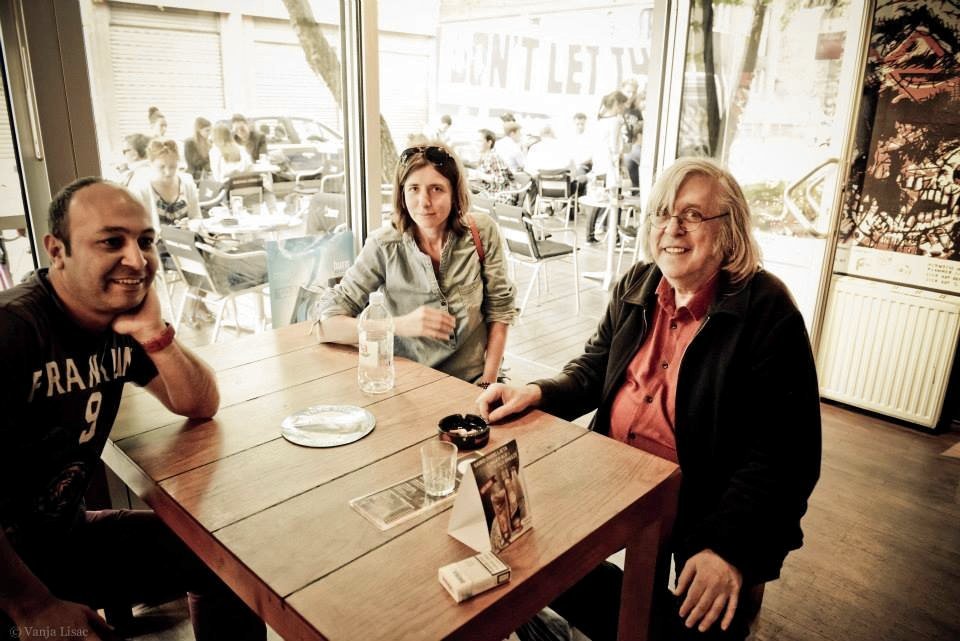
Jonathan Rosenbaum, with colleagues
It was established that I would be dividing each day during the second half of May with Carlos Reygadas – Carlos doing ‘practical’ sessions in the afternoons, and my lectures and screenings in the mornings, held for whoever wanted to show up (which also included some MA students and other visitors).
The original idea was for me to also have public screenings each evening, ideally with some assistance from the US embassy and involving the local community. But shortly before I came I learned that the embassy hadn’t even answered our letter to them, and the further issue of holding public screenings without the proper rights clearances was proving insuperable. All of which is to say that the potential charge of film.factory being an elitist, club-like affair is one that Béla and others are trying to address, even though a satisfactory long-term solution for accomplishing this has yet to be found. (Theoretically, the Sarajevo Film Festival could offer a path, but the fact that it’s held in the summer when film.factory is no longer in session rules out that possibility.)
However, instead of simply cutting my syllabus in half when I discovered that public screenings weren’t possible, I decided to bring along two or three times as many DVDs as I could possibly show and then thrash out which ones with the students (as I was still calling them at this point), based on their own particular interests and orientations. Before I arrived, I even sent along my preliminary list of possible films to show, along with links to pieces about most of them on my web site and the suggestion that they look at my book Movie Wars to get some sense of my overall approach. And during my two weeks of ‘official’ employment, I also managed to lend out a few other DVDs to match certain individual interests (eg Martina Kudláček’s documentary on Maya Deren for a filmmaker who was especially interested in her work, apart from my screening of Meshes of the Afternoon and At Land, and Jon Jost’s Last Chants for a Slow Dance for someone else).
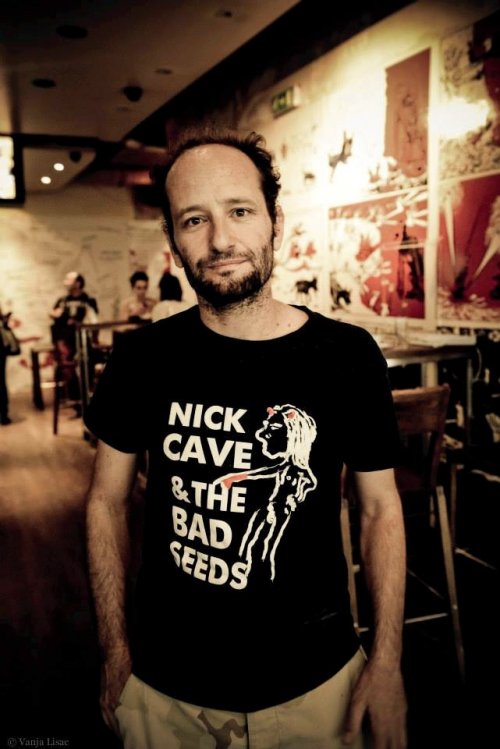
Carlos Reygadas at film.factory
But things changed again – or at least my perception of them did. Because the entire operations were being planned exclusively, and on a day-by-day basis, by Béla, working only with his 33-year-old assistant and programme coordinator Sunčica Fradelić (a visual artist from Split who had also become my main email contact), I soon discovered that one of the main reasons why film.factory wasn’t a school was that it was much closer to a film shoot, something Béla knew and understood a lot better. This meant that everything, my screenings and lectures included, was subject to last-minute revisions due to weather, equipment, health, sudden inspirations and other variables. And bearing in mind Orson Welles’ definition of a film director as someone who presides over accidents – along with the dawning realisation that the same vicissitudes might even apply to film historians, and therefore to what we all know as film history – an important part of my own education over my 18 days in Sarajevo was learning how to roll with all the punches.
Early on, for instance, I discovered that Carlos had already been teaching for a week before I arrived, and would be departing after only three more days, leaving the remaining afternoons free. (Before he left, I was able to attend his informative afternoon session devoted to showing and discussing his first feature Japón – during which he expressed some irritation about the filmmakers not being as punctual or as assertive as he would have liked.)
Thus my own screening and lecture time practically doubled again, especially once it became clear that Tilda Swinton, originally slated to replace Carlos, had to delay her own arrival due to her hectic post-Cannes schedule. Still, I was able to visit her first two remarkable classes as well as two screening sessions of another lecturer, Manuel Grosso, who hailed from Seville and was focusing on Buñuel. (Among the other visiting lecturers who’d preceded us this year were Jean-Michel Frodon, Thierry Garrel, Ulrich Gregor, Fred Kelemen and Gus van Sant.)
Among the other fruits of last-minute scheduling were:
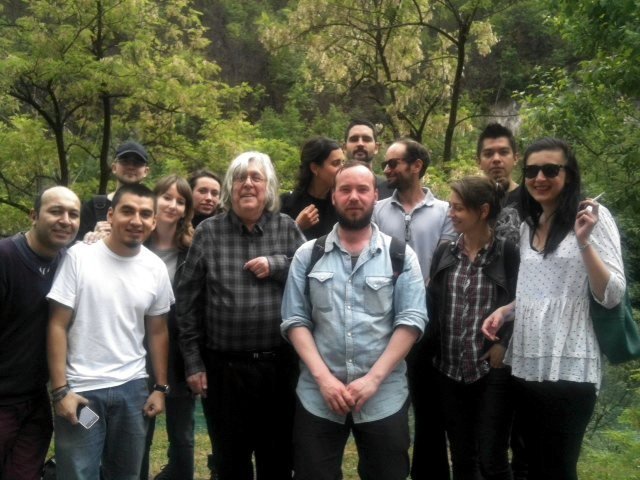
At Bunker Konjic
· a field trip to Bunker Konjic, about an hour’s drive past spectacular mountain scenery from Sarajevo. This underground bomb shelter, built by Tito, seemed as large and as crazy as a small country, not to mention a fever dream out of Dr. Strangelove. Today it’s run by the Bosnian army and currently houses an international art show.

Before a screening of Sátántangó
· a screening of Béla’s 450-minute Sátántangó one Saturday (the first time Sunčica and nearly all the others saw it), introduced by me. This was followed the next day by Béla lecturing for four-and-a-half hours about how he made it, shot by shot and take by take, using a sort of post-it storyboard as his narrative thread. (As with the film itself, there were two intermissions.)
· an earlier marathon screening arranged by me the previous Saturday, held at an apartment occupied by four of the students, which turned out to be the most memorable session we had. (I’ll come back to this.)
At the request of my regulars, we planned another session of this kind, devoted to the re-edit of Welles’ Touch of Evil on which I served as consultant and, if time and energy permitted, John Gianvito’s The Mad Songs of Fernanda Hussein. But this had to be postponed when the other Serb filmmaker, who had been filming all week, made a call for crew members and extras (including myself in the latter group) for a lengthy, rowdy shoot inside a local bar inside a basement that was reportedly the only such establishment to survive the war. Then this rescheduled viewing session was cancelled at Béla’s request when he feared that my hefty programme of screenings, which eventually totaled 21 features and 17 shorts, might be diverting too much attention and energy away from other parts of the programme.
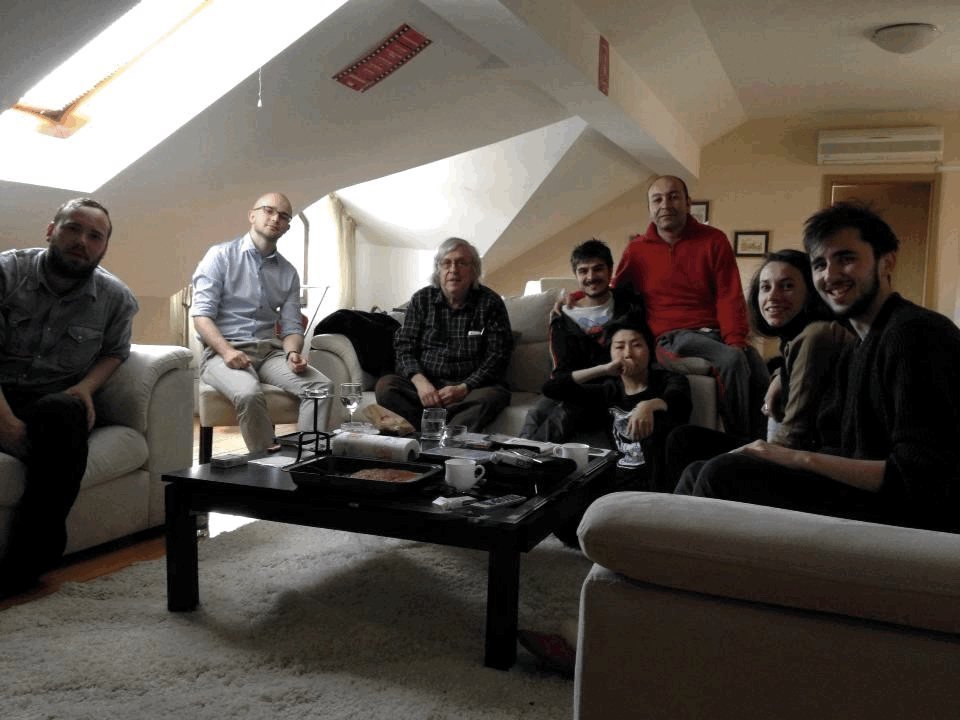
Film-watching in Sarajevo
A few more details about the one marathon screening we did have: by another accident of chance, I’d received news the night before that one of my best friends in Chicago, Peter Thompson – for me the greatest of all Chicago filmmakers, past or present, even though he continues to be among the least well-known, and someone whom I’d befriended in the late 80s because of how I felt about his work – had died, at age 69, after 18 months of terminal illness. (I’m happy to report that a box set including all six of his films and a lengthy interview, meticulously prepared by Peter himself, is currently in the works.) I intended to show only his half-hour Universal Hotel on Saturday, but it had such an impact on those present that I wound up screening all three of Thompson’s other highly personal films that I’d brought to Sarajevo: Universal Citizen and his Two Portraits, the latter about each of his parents.
During his late teens and early 20s, Peter had studied classical guitar with Andrès Segovia and performed at concerts in Europe, and combined with his subsequent academic work in comparative literature, this gives his distinctive voiceovers a literary as well as musical address – “the capacity to suggest infinite reaches with a minimum of photographic ‘evidence’, carefully chosen words, and the articulation of his own voice,” as I later put it on my own web site. And this is what seemed to impress the others the most, despite the absence of any subtitles – that and the feelings expressed, and for what Kaori Oda described to me in a subsequent email as the “strong form” of the rhythm of his images, which made her miss Osaka and “my dear people” there and gave her “a vast space to reflect myself”, while responses from several others at the screening, all of which I was able to convey to Peter’s widow, were equally strong and personal.
For me, this was the high point of all the sessions I’d initiated. But Swinton’s two extended lectures about the ethics and practice of dealing with performers were no less exciting. Both used Robert Bresson’s Notes on Cinematography as a major reference point, and even though this might seem eccentric, it turned out to be concrete and practical, especially once she started filming close-ups of everyone in turn, visible on a monitor, while conversing with each of us on the second day. (I was the first guinea pig in this process.)
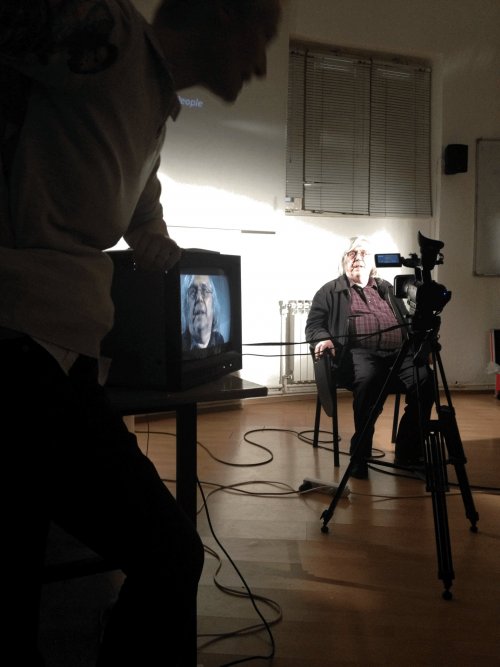
Posing for Tilda Swinton
The focus was mostly on how actors/performers, rather than seek to ‘express themselves’, should minimise their expressions to what’s needed in a particular shot in order to advance a story, and the public dialogues she had with each of us were demonstrations and elucidations of this process, highlighting the degree to which less – by virtue of being isolated and magnified by the camera – invariably registered as more.
Asking each of us to think about something private without verbalising it was a way of getting us to concentrate and thus empty our faces so that small details started to register. When she asked Pilar, one of the Spanish filmmakers – who had previously snapped the photo of Tilda filming me – to pretend she was riding home on a bus, totally exhausted, and so tired that she didn’t even have enough energy to close her mouth, the way her open mouth transformed her close-up on the monitor so that it immediately signified ‘exhaustion’ was immediately apparent. As I said to Tilda afterwards, I felt like I had just been through a session with Socrates.
In closing, I should note that I didn’t start looking at films already made by the ‘factory workers’ until after I returned home, so my experience of film.factory was appreciably different from those of Béla, Carlos and others more engaged with their actual practice. For me it was an adventure having a lot to do with joining and then engaging with a particular community – something I do more often nowadays via the internet, but one in this case that extended my online activity as a writer rather than forge some alternative to it.
Maybe it’s some form of teaching after all, despite what Béla says. But as Tilda and her hyper-alertness clarified, it’s reciprocal education founded on a Socratic model – conversations and dialogue, not preaching and pronouncements. In the past, I’ve often felt hamstrung by students firmly convinced that they can learn anything they need to know without reading. So it was no small pleasure to discover back in Chicago that over 200 visits from Sarajevo had been paid to my website over the previous month.
And in back issues of Sight & Sound magazine
Web exclusive
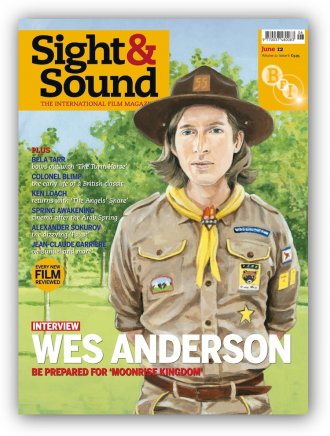
Our June 2012 issue
Gone with the wind
The Turin Horse is the last testament of the legendarily uncompromising Béla Tarr. He talks to Jonathan Romney, while DP Fred Kelemen analyses a remarkable collaboration.
+ Hungarian disharmonies
Last year’s shake-up of funding in the Hungarian film industry has pitted Tarr against a man from the opposite extreme of the film industry – Hollywood producer Andrew Vajna, of Rambo fame. Geoffrey Macnab reports.
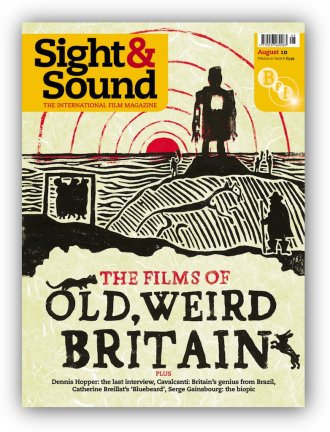
Our August 2010 issue
Going rogue
Filmmaker Treasa O’Brien survives a sense-awakening weekend at Werner Herzog’s Rogue Film School.




